|
Charles Darwin in Hobart Town
Charles Darwin sailed from Sydney in the Beagle
on January 30th 1836 and sailed up the Derwent River to Hobart Town on Friday 5th of February 1836. He sailed out on 17th of February. 'During his visit to Hobart Town Darwin had been impressed by gum trees and tree ferns, had collected 133 different kinds of insect, including notably adaptive dung beetles, flat worms and other animals, and had encountered several sorts of reptiles. Many of the species he collected proved to be new to science.' (Max Banks) He also made significant geological observations during his 12 day stay in Tasmania.
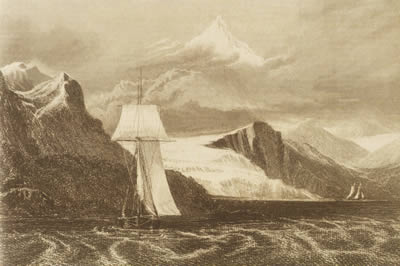
HMAS Beagle by Conrad Martens enlarge |
‘ The voyage of the Beagle has been by far the most important event in my life and has determined my whole career; ... I have always felt that I owe to the voyage the first real training or education of my mind. I was led to attend closely to several branches of natural history, and thus my powers of observation were improved, though they were already fairly developed.’ |
‘February 5th. After six days passage, of which the first part was fine and the latter very cold and squally, we entered the mouth of Storm Bay: the weather justified this awful name. - This Bay should rather be called a deep Estuary, which recieves at its head the waters of the Derwent.’
Right: The Iron Pot Light at the entrance to the River Derwent
Detail of sketch by Darwin’s servant Syms Covington from the Beagle’s deck, February 5th, 1836 enlarge |
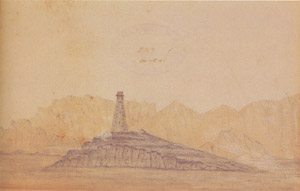
|
First impressions from H.M.S. Beagle on entering the Derwent River
“Near its mouth, there are extensive Basaltic platforms, the sides of which show fine facades of columns; higher up the land becomes mountainous & is all covered by a light wood.- The bases of these mountains, following the edges of the Bay, are cleared & cultivated; the bright yellow fields of corn, & dark green ones of Potato crops appeared very luxuriant.” (Diary)
Darwin, like many other early naturalists and navigators incorrectly described the cliffs at the mouth of the Derwent as being basalt whereas they were in fact dolerite.
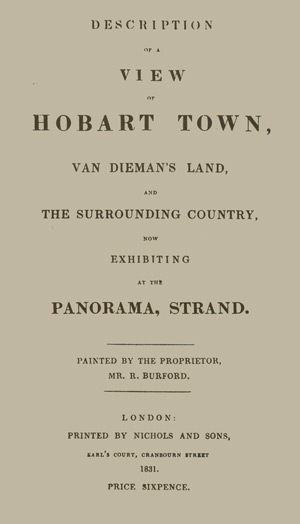 |
Hobart Town Panorama
“In London I saw a Panorama of a Hobart town; the scenery was very magnificent, but unfortunately there is no resemblance to it in nature “ (From Charles Darwin's Diary)
The panorama was prepared by R. Burford and exhibited by him in the Strand in 1831. The key is from a guidebook on sale at the exhibition. The viewer is standing approximately on the site where Secheron was later built. |
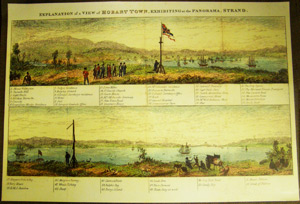 |
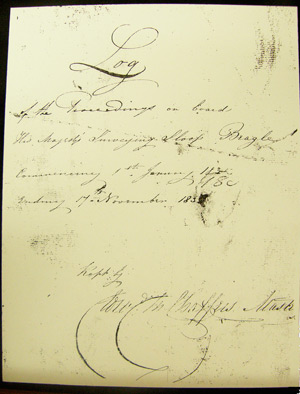 |
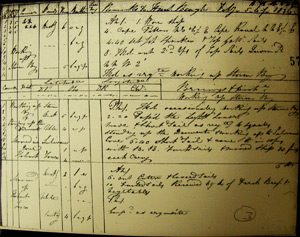
Left and above: Log of the proceedings on board His Majesty’s Surveying Sloop Beagle. The extract of February 5 1836, the day the Beagle with Darwin on board arrived in Hobart Town, mentions rounding Cape Pillar and Cape Raoul and entering Storm Bay
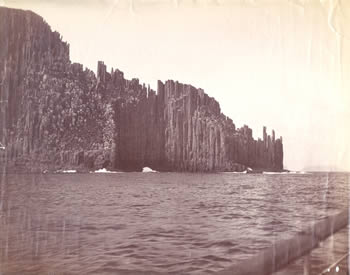
Photograph of Cape Pillar - by James Backhouse Walker
More information.
|
First impressions of Hobart Town
“Late in the evening we came to an anchor in a snug cove, on the shores of which stands the capital of Tasmania, as Van Diemen’s Land is now called.- The number of Ships was not very considerable.- The first aspect of the place is very inferior to that of Sydney; the latter might be called a city, this is only a town.- In the morning I walked on shore,- The streets are fine & broad; but the houses rather scattered; the shops appeared good: The town stands at the base of Mt. Wellington, a mountain 3100 ft, but of no picturesque beauty: from this it receives a good supply of water, a thing which is much wanted in Sydney.- Round the Cove, there are some fine Warehouses; & on one side a small Fort – Coming from the Spanish Settlements, where such magnificent care has generally been paid to the fortifications, the means of defence in these parts appeared very contemptible.” (Diary)
“7th…10th During these days I took some long pleasant walks examining the geology of the country.- The climate here is much damper than in New S. Wales & hence the land is much more fertile. Agriculture here flourishes; the cultivated fields looked very well & the Gardens abounded with the most luxuriant vegetables & fruit trees. Some of the Farm houses, situated in retired spots had a very tempting appearance. The general aspect of the Vegetation is similar to that of Australia; perhaps it is a little more green & cheerful & the pasture between the trees, rather more abundant.-“ (Diary)
In his 1839 Journal Darwin expanded on the geology and inserted the following explanation after the first sentence of the above entry
“ The main points of interest consist, first in the presence of certain basaltic rocks which evidently have flowed as lava; secondly, in some great unstratified masses of greenstone; thirdly, in proofs of an exceedingly small rise of the land; fourthly, in some ancient fossiliferous strata, probably of the age of the Silurian system of Europe; and lastly, in a solitary and superficial patch of yellowish limestone or travertine, which contains numerous impressions of leaves of trees and plants, not now existing. It is not improbable that this one small quarry, includes the only remaining record of the vegetation of Van Diemen’s Land during one former epoch.”
Social Life in Hobart
The "agreeable evening” mentioned below was passed at Surveyor-General George Frankland’s Secheron, Battery Point on the 12th of February, Darwin’s twenty-seventh birthday “I had been introduced [to] Mr. Frankland, the Surveyor-General & during these days I was much in his Society.- he took me two very pleasant rides & I passed at his house the most agreeable evening since leaving England. There appears to be a good deal of Society here: I heard of a Fancy Dress Ball at which 113 were present in costumes! I suspect also the Society is much pleasanter than that of Sydney. They enjoy the advantage in there being no wealthy Convicts. …The Colony moreover is well governed; in this convict population, there certainly is not more, if not less, crime than in England.”
The night after his birthday Darwin was hosted by Alfred Stephen, Attorney-General and owner of Stephenville “ the house large, beautifully furnished, dinner most elegant …an excellent concert of rare Italian music”.
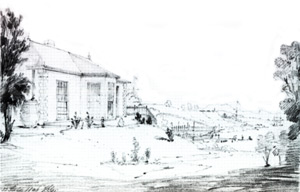 |
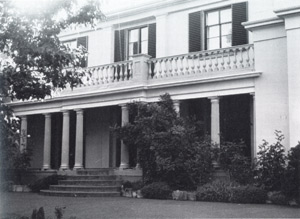 |
| Secheron house, Battery Point |
Stephenville, now part of Collegiate School, Hobart |
|
Civilization in Van Diemen’s Land? Darwin’s Problematic ‘Yes’
by Michael Roe
[from:Royal Society of Tasmania, Davies, Margaret (ed), Charles Darwin in Hobart Town, Royal Society of Tasmania, Hobart, 2009]
Darwin’s visit to Van Diemen’s Land offers various matters of interest to a general historian. An issue to have engaged my own fairly recent attention is the wreck of the convict transport George the Third in D’Entrecasteaux Channel, just ten months before Beagle anchored here. That wreck, and others following, aroused much criticism of the colony’s maritime services. Most of the notice Beagle received in the local press – a varied and vigorous entity – related to this background (Newspapers 1836). One report deplored the inefficiency of signalling the ship’s arrival and said that its master showed knowledge of ‘how totally useless pilots were’ by himself finding way to harbour ‘in gallant style’; another comment called for Beagle to survey the area where George the Third had wrecked, and debate proceeded as to whether observers on the shiphad discovered that previous reckoning of Hobart’s terrestrial position was astray. With broader awareness, one journalist, while not naming Darwin, told that the voyage ‘has made an immense collection of contributions for the illustration of natural history’. Other issues of newspaper report and debate had more distant, but still perceptible links with our subject. Education was among them, and on the very day of Beagle’s arrival, 5 February 1836, an editorial proclaimed that ‘science, the natural associate, but long alienated helpmate of literature, is gradually coming by the voice of common sense in all our most approved places of instruction, into closer alliance.’
While Beagle’s presence stood supreme in the annals of Science in Van Diemen’s Land, February 1836, it was not alone. Then also lying at Hobart Town was Boadicea, which had brought a shipload of free immigrant females – the morality and general sense of that project being another subject of press controversy. Surgeon on the Boadicea was one John Vaughan Thompson, on his way to a senior position with the convict department in Sydney. Thompson was a marine scientist of high achievement; it is recognised more by posterity than contemporaries, but Darwin himself was to use and admire Thompson’s work (Davis 2004). The two appear never to have met, here or elsewhere. Also in Hobart through these days was James Backhouse, most famed as Quaker missionary but also a considerable naturalist. Backhouse’s letters tell of current religious activity, but now too was published his defence of an earlier account of aggression in the local wedge-tailed eagle. ‘Those persons who use their opportunities of examination and observation will often meet with facts that may appear strange to those who neither examine nor observe’, affirmed Backhouse; ‘it is as possible to be absurdly incredulous as absurdly credulous’ (Newspapers 1836). Supreme among resident naturalists was Ronald Campbell Gunn, then living at Launceston. Another event of that 5 February was for Gunn to write to William Hooker, Director of the Kew Gardens and particularly interested in Tasmanian botany (Burns & Skemp 1961, 54-5). Gunn long acted as Hooker’s collector, and in 1840 met his son (James Dalton), who came to the island with the Erebus/Terror Antarcticexpedition — so venturing in deliberate emulation of Darwin’s service on Beagle. Having returned to Britain, J.D. Hooker continued his father’s link with Gunn, and himself became the paramount scholar of Tasmanian botany. That subject was one of many that he discussed with Darwin, the pair becoming close friends and colleagues. This story will have further reference from both myself and Dr Banks.
Contributors to this symposium, and other scholars too, have shown that Darwin’s sojourn here had its part – modest yet characteristic – in the burgeoning of his genius as a naturalist. Yet, just as his concept of evolution was to affect thinking about society, so interest attaches to what Darwin said about human life as he saw it on the Beagle voyage. That was true of Van Diemen’s Land. In turn, a fair proportion of his pertinent comments related to ‘civilization’, that very word often being used by him. The title of my paper affirms that Darwin saw civilization as part of the Vandiemonian story – yet in a way that poses difficulties of analysis and judgment.
My argument can begin with sentences from the ‘retrospect’ that ended Darwin’s Journal aboard Beagle, first published in 1839: Australia is rising, or indeed may be said to have risen, into a grand centre of civilization, which, at some not very remote period, will rule as empress over the southern hemisphere. It is impossible for an Englishman to behold these distant colonies, without a high pride and satisfaction. To hoist the British flag, seems to draw with it as a certain consequence, wealth, prosperity, and civilization (Darwin 1839, 607).
These words show Darwin as product and admirer of Britaindom as it currently advanced towards such economic and political ascendancy as is now difficult to grasp. This cast of Darwin’s mind, I suggest, was a logical, even the necessary context for development of his theory of evolution, as directed by natural selection. He saw dynamic creativity, beset with conflict but working for ultimate good, to characterise imperial Britain, and the same conceptual pattern underlay his key doctrines. Thus, I believe, empire and Darwinian evolution were symbiotic. Proof of such a contention is impossible, however, and even if granted stands open to varying interpretation: some might see the claim to reveal just how potent for good and truth was imperial Britaindom; others as showing Darwinism to be a social, time-bound product.
Whatever, Darwin looked on the socio-political world with a positive eye. His temper was conservative but in liberal, or – in early nineteenth-century terms – ‘Whiggish’ mode. He believed that under enlightened, Britannic-style guidance, improvement was the natural order of events. It is appropriate that Darwin’s autobiography should speak approvingly of Lord (Thomas Babington) Macaulay, a scholar dominant in shaping the so-called ‘Whig interpretation of history’. Referring especially to British affairs, this concept told that events had worked to admirable conclusion, and that the historian’s essential task was to study how this happened. Darwinian evolution, one might dare say, is the Whig interpretation of biology. An allied point was made in 1896 by William Jethro Brown, Professor of Law and Modern History at the infant University of Tasmania – ‘the doctrine of Evolution is an application of the historical method to the natural sciences’ (Roe 1984, 25). (In modest, but still presumptuous way, this paper applies ‘historical method’ to Darwinism.)
Whig values, I suggest, underlay Darwin’s passage about ‘Australia … rising … into a grand centre of civilization’. From our Vandiemonian perspective a crucial element in that quotation is its citing Australian colonies, plural. Darwin noted the difference in scale between New South Wales and the situation here – Sydney already a city, Hobart rather a town, ran one comment – but the island yet had its place in the story of imperial progress. It was from Hobart that Charles told his sister Catherine that ‘it is necessary to leave England, & see distant Colonies of various nations, to know what wonderful people the English are’ (Darwin Correspondence Project 298). Indeed one might argue that while stressing (even exaggerating, for that time) the quantitative gap between the two colonies, Darwin saw qualitative virtue in the smaller place. Concerning New South Wales he emphasised that wool and whaling were the great money-makers, albeit (he believed) likely soon to be exhausted. Pastoralism had its place in the Vandiemonian economy, Darwin realised: ‘It is no small triumph to Van Diemens Land, that live sheep have been imported from a colony of thirty three years standing to this one, founded in 1651’ went a diary entry at the Cape of Good Hope, visited on Beagle’s homeward way (Darwin 1988, 424). However, this was an aspect of our place Darwin chose not to emphasise – the passage just quoted did not re-appear in his published Journal. By contrast, both sources evoked local agriculture. As Beagle approached portthe observer noted that‘edges of the bay are cleared & cultivated, the bright yellow fields of corn, & dark green ones of potato crops appear very luxuriant’. Further acquaintance confirmed the point: ‘Agriculture flourishes; the cultivated fields look well, and the gardens abound with thriving vegetables and fruit-trees. Some of the farm-houses, situated in retired spots, had a very attractive appearance.’ The effect, Darwin told his sister was to ‘most delightfully resemble England’. Even natural vegetation was ‘a little more green and cheerful’ than in New South Wales, his sweeping generalisation presenting higher rainfall as the cause.
All this related to our theme of ‘civilization’. A long tradition especially of European thought, postulates agriculture as inherently virtuous, in contrast with primitive pastoralism. Such were Darwin’s values. A symbol was his later reference to discussing shore-lines at Ralphs Bay with ‘an intelligent farmer’ (Darwin 1844, 141): intelligence and farming went together. Darwin further approved the local economy’s evolution towards modernity. One of his extremely rare uses of an exclamation mark in the Journal ended a reference to the steam-ferries that plied the Derwent. ‘The machinery of one of these vessels was entirely manufactured in the colony, which from its very foundation, then numbered only three and thirty years!’
Surpassing naturalist though – or because – he was, Darwin recognised the threat to man from Nature in wild and violent mode. I see it as part of his sympathy for Van Diemen’s Land that he downplayed the local force of Nature. A symbol for this attitude could be that he assumed all Vandiemonian reptiles were benign, thereby risking his life (Shine & Hutchinson 1991). Making the point in another way were Darwin’s dismissive remarks about Mount Wellington. Some admiration went to tree ferns and eucalypti within its valleys, but otherwise he found ‘little picturesque beauty’ in Wellington, even that diminished by the ‘vast number of little red brick dwellings’ on its urban edge. In all the many editions of Darwin’s Journal Wellington’s height is given a thousand feet short. He found the vista from the peak ‘flat … tame’, and likewise his diary remarked that ‘in London I saw a Panorama of Hobart town; the scenery was very magnificent, but unfortunately there is no resemblance to it in nature’. That ‘unfortunately’ undercuts my argument that Darwin‘s dilution of Nature’s local force showed his warmth for the place, but still I maintain it. The key evidence also comes from the diary: ‘if I was obliged to emigrate I should certainly prefer this place: the climate & aspect alone would determine me’. Unpicturesque and unmagnificent that aspect might appear to him, but such was what our Nature-deprecating man liked. His favourable reference to climate ran parallel. Cloud and rain beset Hobart through February 1836, but seemingly this very ordinariness had its appeal.
The diary praised further:
'I had been introduced [to] Mr Frankland, the Surveyor-General & during these days I was much in his Society. – He took me two very pleasant rides & I passed at his house the most agreeable evening since leaving England. There appears to be a good deal of Society here: I heard of a Fancy Dress Ball at which 113 were present in costumes! I suspect also the Society is much pleasanter than that of Sydney. They enjoy the advantage in there being no wealthy Convicts. … The Colony moreover is well governed; in this convict population, there certainly is not more, if not less, crime than in England'.
Darwin’s coincident letter to Catherine went in similar vein. Most intriguing of issues thus raised are the joint matters of convictism and government. It was another of Darwin’s big generalisations to say that criminality stood less in the island than back home, but the case was arguable: Lieutenant-Governor George Arthur’s mighty efforts in this direction indeed had their impact, if not so total as their author would have liked. Darwin exaggerated too in saying that the island had ‘no wealthy Convicts’, but certainly the cohort was less assertive than in New South Wales. Jealousy between ex-convicts and cleanskins Darwin found a salient evil of the older colony. This attitude bespoke his social values and background: he vaunted an ordered society in the double sense – of being obedient, and comprising well-demarcated sectors. ‘Whether we look at it as a cause or a consequence, the more civilized always have the most artificial governments’, Darwin elsewhere affirmed (Darwin 1839, 242). The context suggests that by ‘artificial’ he meant action so structured as to foster a society that was ‘ordered’ in the double sense. Such a criterion indeed could win Darwin’s approval for Arthur’s regime.
Whereas ex-convicts poisoned affairs in New South Wales, Darwin repeated to Catherine, ‘there is a better class of Society here’. Accordingly, for those not attached to specialist interests, ‘it is a most admirable place of emigration’, with certain promise of moderate wealth. Emigration was an issue that Darwin specified as among his prime interests when coming to Australia, and it had a big place in imperial debate at this time. As already apparent and will further appear, Charles sometimes played with the notion of himself transmuting. Vandiemonian prosperity was nearing its end by 1836, but he evidently found no intimations of that. His major contacts were with bureaucrats, who received and spent substantial salaries, as well as being capable and cultured.
Surveyor-General George Frankland was an ideal companion for Darwin; helping with the scientific researches that the traveller ever pursued – and which especially the other contributors to this symposium address. Happily, that ‘most agreeable evening since leaving England’ passed at Frankland’s splendid ‘Secheron’, Battery Point, on 12 February, Darwin’s twenty-seventh birthday. Next night the traveller’s host was Alfred Stephen, Attorney-General and owner of ‘Stephensville’, surviving as the centrepiece of Collegiate School. ‘The house large, beautifully furnished, dinner most elegant … an excellent concert of rare Italian music’, Charles told Catherine. ‘Stephensville’ had been the site of that mighty fancy-dress ball, while 96 guests had recently danced at ‘Secheron’. ‘Is not this astonishing in so remote a part of he world?’, asked the traveller. Another boast of ‘Stephensville’ was its ‘respectable (although of course all Convict) Servants.’ Perhaps Darwin’s emphasis on ‘respectable’ suggested that this was a matter more of appearance than reality, yet still his words implied approval for convicts achieving social mobility – within ordered limits.
The hospitality that Charles enjoyed in Hobart perhaps contributed to his outlays here being modest, so he did not have to fulfil an earlier intent to draw a bill on his father. He told this to Catherine with some relief, and his spirits might thereby have risen all the higher. His second extant letter from Hobart, to second-cousin W.D. Fox, hinted at yet more personal thoughts (Darwin Correspondence Project 299). It spoke of Beagle’s homeward journey including Mauritius, site of the archetype romantic novel, J.H. St Pierre’s Paul et Virginie (1787)., ‘Oh that I had a sweet Virginia to send an inspired Epistle to’, mused the traveller. Did a Hobart girl inspire such fantasy? Darwin scarcely ever alluded to his sexual being.
This letter to Fox has greater import, forcing more confrontation with ‘problematic’ elements in our story. Written on 15 February, its overall thrust went counter to what has been said so far. While still lauding the Australian colonies for ‘far outstripping in Civilization those of S.America’, Darwin now said that for him personally the time since Beagle left South American waters comprised ‘so much existence obliterated from the page of life’. His own recent researches had been paltry, even the geological essays he had compiled ‘cannot be of much use’. He would be ‘very loth to emigrate. The moral state of the lower orders is of course detestable, the society of the higher is rancorously divided by party feeling & the country is not to me pleasing’.
How did such judgements relate to that celebration of Hobart we have earlier noted? If British Australia had these faults, just what did Darwin see as the civilization he otherwise said it to display? Presumably most of his animus was directed against New South Wales, but he made no effort to distinguish between mainland and island. Nor is it satisfying to dismiss the letter as product of home-sickness and exhaustion, emphatic though Darwin was in admitting such feelings. Charles’s disdain for our part of the world had further expression. He wrote another sister, Caroline, that ‘I did not feel much affection for any part of Australia’ (Darwin Correspondence Project 301), and the final relevant words of the Journal repeated that sentiment. The young man could not have known that posterity would study all his words, threatening to impose an absurd load upon them, but such contrariness remains puzzling indeed...
The future saw a turn of this wheel. Already I have referred to the association that developed in the 1840s between Darwin and Joseph Dalton Hooker. Increasingly the latter was occupied in his studies of Tasmanian flora. By this time Hooker’s keenest Tasmanian admirer was William Archer, intellectual star of a remarkable family. Archer engaged in politics, in 1851 becoming a member of the colony’s first part-elected Legislative Council. In 1853 he there carried a motion that government should contribute towards publication of Hooker’s work. The proposal won approval from the current Lieutenant-Governor, William Thomas Denison. We might expect that response from the man who achieved the survival of our Society by securing its merger with the Tasmanian Society – ’Royal’ continuing the title, although the ‘Tasmanian’ had a more impressive record. Denison’s support for the Hooker grant was so much worthier in that Archer disputed the Governor’s advocacy of continued transportation of convicts, the key political issue of those days. Archer belonged to the local Royal Society, his depiction of native orchids gaining appropriate praise within that body.
In the event, the grant amounted to £300, conditional on six copies of Hooker’s work being given to Tasmanian institutions. The episode had two interesting aftermaths. Archer subsequently proposed to Denison that the British government might fund publication of imperial data concerning a range of sciences; Denison, by now Governor of New South Wales, duly submitted the idea to London – but to no avail (Von Mueller 1998, 463). Meanwhile, on 26 February 1854, Hooker had informed Darwin of the Legislative Council’s generosity (Darwin Correspondence Project 1557 and [response]1556). Our hero’s response will be told you by Max Banks. To my mind it virtually clinches that Darwin’s dominant picture of the island was of a positive, attractive, civilized place.
Hooker’s complete Tasmanian work, with a massive introduction covering Australian botany at large, was published just a few weeks after The Origin of Species in 1859-60. Its support of Darwinian ideas did much to further their acceptance. The 1859 Origin had a few Tasmanian references, but its chief local import lay in provoking response from Benjamin O’Neile Wilson, one-time Hobart journalist and later Parliamentary official. Wilson applauded Darwin’s remarks on the variation of instinct in domestic animals, while remarking that colonists were more likely than stay-at-homes to know about such matters (Darwin Correspondence Project 3348). He provided comment on breeding patterns of local stock that won place in Darwin’s Variation of Animals and Plants under Domestication (Darwin 1868, 1; 83). Tasmanian scored yet higher in the 1872 edition of Origin,as Darwin proposed that resemblance between the jaws of thylacines and dogs showed how selection worked in similar way on ‘quite distinct beings’ (Darwin 1872, 374). An exhibition held at the British Museum on the centenary of Darwin’s birth included a thylacine skull that illustrated the argument (British Museum 1909, 49). Darwin gave occasional heed to other aspects of Tasmanian science (Darwin Correspondence Project especially 3298 and 4560). His geological concerns included the island’s experience of glaciers, and what its pre-history told of land-mass movement.
***
Against these positives stood Darwin’s commentary on the Tasmanian Aboriginals. Here the ‘problematic’ element in our subject assumes a different and sombre order. Darwin ever believed in there being a hierarchy of races, those at the scale’s upper end destined to increasing dominance. That stance caused him to see the Tasmanians’ post-settlement experience as a result of, and indeed a stimulus to, civilization’s progress.
It adds depth to the issue that Darwin’s human sympathies sometimes crossed the racial divide. Well-known is his abomination of slavery, that issue for a while embittering relations with Beagle captain, Robert FitzRoy. Darwin’s account of Rio de Janeiro in April 1832 deplored slavery’s local guise, in sensitive style. It told how one woman escapee from bondage made a suicidal leap. ‘In a Roman matron’, declared the Journal, ‘this would have been called the noble love of freedom: in a poor negress, it is mere brutal obstinacy’ (Darwin 1839, 22). That is an interpretive insight such as one might expect from a scholar of today, aware of gender nuances and ‘history from below’.
Darwin could be likewise alert and generous towards indigenous peoples. The hunting skills of Australian Aboriginals were chief among attributes that prompted him to declare these people ‘far from being such utterly degraded beings as they are usually represented’ (Darwin 1839, 519). He recognised that white settlement had intensified the nomadic element in Aboriginal life, and saw that process as one cause of population decrease. Yet the general thrust of Darwin’s remarks went in the opposite direction. Aboriginals’ skills sufficed only to make them ‘appear to me to stand some few degrees higher in the scale of civilization than the Fuegians’. Darwin saw the Australians’ population decline as inexorable, an instance of the rule that contact between ‘the varieties of man’ led to ‘the stronger always extirpating the weaker’.
Darwin said less about the Tasmanians, but to like effect. Before detailing that case, a detour is appropriate. Apropos both mainland and local Aboriginals the Journal said more than did his on-the-spot diary and letters. The margin is wider than is the case with material discussed earlier in this paper. This pattern appears to have been partly the result of broader developments in Darwin’s thought. From mid-1837 he pondered issues relating to natural selection, keeping relevant data in a set of note-books. They show that already Darwin saw mankind as subject to the same processes as were other biological forms.
Awareness of the Tasmanians reflected, even might have prompted, such thinking. Darwin wrote in his on-the spot-diary of 1836:
'The Aboriginal blacks are all removed & kept (in reality as prisoners) in a Promontory, the neck of which is guarded. I believe it was not possible to avoid this cruel step; although without doubt the misconduct of the Whites first led to the Necessity – '
Here confusion reigned, not only apropos the facts of managing convicts and Aboriginals, but more importantly as to judgment. By this analysis, what happened to the Aboriginals was cruel, but also necessary, and the outcome of the necessity benefited those responsible for the cruelty. Our man of human sympathy saw the moral dilemma, and perhaps he wanted to resolve it. Back in Britain came that period of preparing the Journal for publication while coincidentally musing on natural selection. Darwin’s note-book spanning October 1838 to July ’39 included this passage:
'When two races of men meet, they act precisely like two species of animals, – they fight, eat each other, bring diseases to each other &c., but then comes the most deadly struggle, namely which have the best fitted organization, or instincts (i.e. intellect in man) to gain the day. – In man chiefly intellect, in animals chiefly organization, though Cont. of Africa & West Indies shows organization in Black Race there gives the preponderance, intellect in Australia to the white … & in Van Diemen’s Land – they have been exterminated on principles strictly applicable to the universe … '(Darwin 1960, 166).
The third sentence onwards affirmed, ‘Man acts & is acted upon by the organic and inorganic agents of this earth like every other animal’. Universal forces, beyond good and evil, caused such phenomena as the Tasmanians’ fate.
Before writing up the Journal, Darwin hadgot his facts straighter, especially by having read (in Bischoff’s Van Diemen’s Land) about armed conflict between colonists and Aboriginals. The Tasmanians’ bush skills caused the Black Line of 1830 to fail in the short term, now went his analysis, yet thereby was conveyed to them ‘the power and numbers of the whites’. So the way opened for the ‘intrepid exertions’ of George Augustus Robinson and Aboriginal deportation to Flinders Island. The moral quandary expressed in the diary re-echoed. Darwin characterised the amoval as ‘most cruel’, ultimately rooted ‘in the infamous conduct of some of our countrymen’, yet he judged the only alternative to have been total slaughter of the Aboriginals and saw as a further outcome ‘that Van Diemen’s Land enjoys the great advantage of being free from a native population’. Still more revealing, and crucial to my theme, ran a further grim comment: ‘I do not know of a more striking instance of the comparative rate of increase of a civilized over a savage people’.
That this sentence did not appear in later editions of the Journal might have indicated a further twinge of the author’s conscience, but his basic thinking continued the same. Instead of that particular sentence, later editions of the Journal gave figures as to continuing Aboriginal depopulation, drawn from De Strzelecki’s Physical Description of New South Wales and Van Diemen’s Land. The second (1882) edition of Darwin’s Descent of Man, first published in 1871 and scarcely less crucial than The Origin, included the Tasmanians in a section on ‘the extinction of races’; their fate was invoked to confirm that ‘the grade of civilization seems to be a most important element in the success of competing nations’. The Descent cited comment of a local observer that deaths intensified ‘following attempts to civilize the natives’, suggesting that incapacity to accept this offering had fixed their doom; Darwin now ignored European violence as a root cause of depopulation (Darwin 1882, 183-4). He had continued relevant reading, his further chief source being James Bonwick’s Last of the Tasmanians. As if in anticipation, Bonwick had studied Darwin (Butcher 1994). He abhorred Darwinian racial ideas, yet concurred that the Tasmanians’ fate fulfilled the seer’s judgment as to how contact between ‘varieties of man’ ended with ‘the stronger always extirpating the weaker’. Darwin gave no heed to Bonwick’s values.
An earlier claim of this paper was that Darwinian evolution was symbiotic with British imperialism. That symbiosis is all too evident in the matters I have just related. Circumstance and culture determined the values of Darwin’s time, and of ours, but there remains some right of judgment. It must declare that here lay a dark side of both Darwin’s genius and British imperialism, and so of the civilization which sustained both and which both upheld.
REFERENCES
Note: this list contains some items beyond those specified in the text.
BACKHOUSE, J., 1838: Extracts from the Letters of James Backhouse. Third part. Harvey and Dalton, London.
BISCHOFF, J., 1832: Sketch of the History of Van Diemen’s Land. John Richardson, London.
BONWICK, J., 1870: The Last of the Tasmanians. Sampson Low, London.
BRITISH MUSEUM, 1909: Memorials of Charles Darwin. British Museum, London. The commentary suggests that Darwin simplified/exaggerated the similarities.
BURNS, T.E. and SKEMP, J.R., 1961: Van Diemen’s Land Correspondents … 1827-1849. Queen Victoria Museum, Launceston.
BUTCHER, B.W., 1989: … Charles Darwin’s Use of Australian Resources, 1837-1882. Historical Records of Australian Science 8: 1-14.
BUTCHER, B.W., 1994: Darwin, Darwinism, and the Australian Aborigines, in R. McLeod and P.E. Rehbock (Eds): Darwin’s Laboratory. University of Hawaii, Honolulu: 371-94. My thinking is close to Butcher’s; happily my own earlier work was of some (small) help to him.
DARWIN, C., 1839: Journal and Remarks, 1832-1836. This was volume 3 of the Narrative of the Surveying Voyages of His Majesty’s Ships Adventure and Beagle. Henry Colburn, London. The major Tasmanian references are at 532-6.
DARWIN, C., 1844: Geological Observations on the Volcanic Islands visited during the Voyage of H.M.S. Beagle. Smith Elder, London.
DARWIN, C., 1859: On the Origin of Species by Means of Natural Selection. John Murray, London.
DARWIN, C., 1868: The Variation of Animals and Plantsunder Domestication. John Murray, London. 2 vols. This (the first) edition seen only on the internet at >darwin-online.org.uk<.
DARWIN, C., 1872. On the Origin of Species by Means of Natural Selection. John Murray London. This (the sixth) edition also seen only at >darwin-online.org.uk<.
DARWIN, C., 1882: The Descent of Man and Selection in relation to Sex.John Murray, London. This (the second) edition also seen only at >darwin-online.org.uk<.
DARWIN, C., 1958: The Autobiography of Charles Darwin (N. Barlow, Ed). Collins, London.
.
DARWIN, C., 1960: Notebooks on Transmutation of Species (G. De Beer, Ed). Part Four. British Museum, London.
DARWIN, C., 1988: Charles Darwin’s Beagle Diary (R.D.W. Keynes, Ed). Cambridge University Press, Cambridge. The major Tasmanian references are at pages 408-10.
DARWINCORRESPONDENCE PROJECT. This massive enterprise is in process of hard-copy publication, but easier availability is at the internet site darwinproject.ac.uk
References are to the numeration of items therein.
DAVIS, P., 2004: Thompson, John Vaughan (1779-1847). Oxford Dictionary of National Biography 34: 453-4.
DE STRZELECKI, P.E., 1845: Physical Description of New South Wales and Van Diemen’s Land. Longmans Brown Green, London.
HOOKER, J.D., 1860. The Botany of the Antarctic Voyage of H.M. Discovery Ships Erebus and Terror … . Part III, Flora Tasmaniae. Lovell Reeve, London.
NEWSPAPERS, 1836: Hobart Town Courier, 5 February (science and learning), 12 February (survey), 19 February (collections and Backhouse); Colonial Times, 9 February (arrival); True Colonist, 12 February (survey); Bent’s News, 5 March (chronometry); Tasmanian and Review, 1 April (terrestrial position). Peter Stephenson, Hobart, currently is studying the matters of chronometry and location.
NICHOLAS, F.W. and M., 1989: Charles Darwin in Australia. Cambridge University Press, Cambridge.
ROE, M., 1984: Nine Australian Progressives. University of Queensland Press, Brisbane.
ROE, M., 1986: Darwin in Hobart, 1836. Island 28: 16-8.
SHINE, R. and HUTCHINSON, M., 1991: Charles Darwin in Tasmania. Australian Natural History 23: 794-801.
VON MUELLER, F., 1998: Regardfully Yours … Selected Correspondence (R.W. Home et al., Eds). Volume One. Peter Lang, Bern.
|









